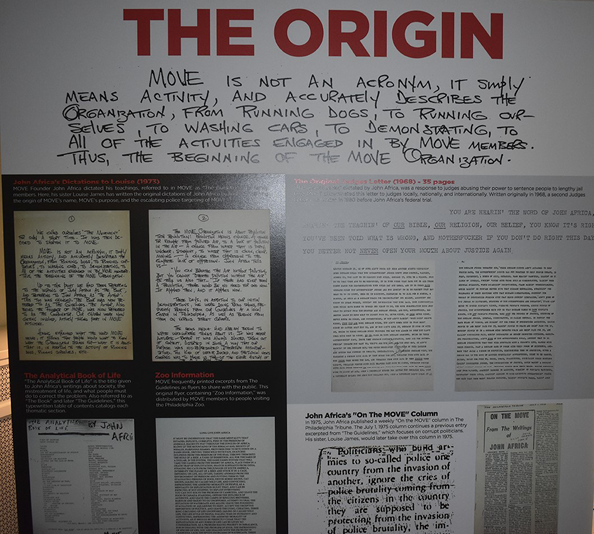PHILADELPHIA—In a poignant commemoration of the 1985 MOVE bombing carried out by Philadelphia police, the powerful pop-up archival exhibit “MOVE:
The Old Days” was recently unveiled at the Paul Robeson House and Museum at 4951 Walnut Street in Philadelphia. This stunning historical exhibit, which was years in the making, spans four rooms and was on display on May 16, 18, and 19.
It offered an informative educational experience, beginning with the harrowing 1985 assault on MOVE’s home that resulted in a deadly fire claiming 13 lives.

As visitors journey through the exhibit, they are taken back in time to 1978 and the intense police assault where 10,000 rounds of ammunition were fired, leading to the imprisonment of nine MOVE survivors for 40 years. This emotional and breathtaking exhibit offers an in-depth look at a dark chapter in the city’s history.
“The Move Activist Archive stands as a stunning testament to the power of community and the enduring legacy of Black activism and resistance in Philadelphia,” said Mike Africa Jr., who led the project.
“We worked with Black activists, researchers, community members, and organizations like the West Philadelphia Cultural Alliance/Paul Robeson House and Museum, Reclaim Osage, and Re/Member Black Philadelphia,” Mr. Africa added.
Their goal is to preserve the organizational history and collective memory of the MOVE organization. Through the dedication of family members Louise James and LaVerne Sims, a wealth of historical materials has been meticulously preserved to narrate an emotional and educational story.
“The archive not only offers valuable insights into the diverse landscape of Black activism but also serves as a historical showcase that motivates future generations to carry on the struggle for justice and equality,” he continued.
The historical exhibit captures the powerful narrative of MOVE, a revolutionary organization rooted in Philadelphia. The collection features never-before-seen photos, documents, artifacts, and unpublished political writings that bring the rich history of MOVE and its members to life.
As guests navigate through the exhibit, there are personal items, such as Ramona Africa’s iconic original bullhorn, alongside 50 years of captivating photographs and memorabilia.
The educational journey offered an emotional and excellent opportunity to delve into the profound legacy of MOVE, providing rare insights and unforgettable experiences through audio and visual recordings.
The “MOVE: The Old Days” exhibit showcases the events leading up to the May 1985 bombing and delves into the origins of MOVE and its ideology.
Created in 1972 by John Africa, MOVE was a communal living organization dedicated to promoting natural living and environmentalism. However, their unconventional lifestyle and radical beliefs often clashed with local authorities, resulting in numerous altercations, arrests, and deaths.
Diamante Ortiz, a Philadelphia native, told The Final Call, “I was amazed by the exhibit. It was incredible to witness the stories of [the] Move Nine and Mumia Abu Jamal come alive in such a pivotal year and space.” For Ms. Ortiz, the experience was transformative and served as a reminder of the recurring patterns in history.
“It stands as a powerful testament to the resilience of the Black community in Philadelphia and the enduring legacy of MOVE, notably with Mike Africa Jr.’s involvement in guiding the tour.”
James Singletary is also from Philadelphia. “Witnessing history come alive before my eyes was nothing short of transformative. Seeing the scars of the past—burned remnants and preserved archives—offered a raw, unfiltered glimpse into the struggles and resilience of those who came before us,” he said.
“Each story of hardship and triumph resonated deeply within me, igniting a newfound urgency to seek knowledge and clarity. I feel a compelling need to bridge the gaps in my understanding, to immerse myself in books and resources that shed light on these hard-fought truths.
This experience has not just moved me, but propelled me towards a mission: to learn, to comprehend fully, and to do my part in ensuring such histories are never forgotten, and such tragedies never repeated.”















